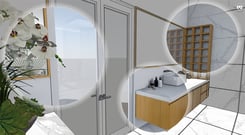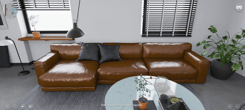Over the years, we have studied and observed an interior designer’s workflow and the specific points of friction they encounter each project. It’s no secret that one of the most inconvenient barriers in completing a project is the time it takes to render the final image and create content ready for VR. Depending on a variety of factors, the processing time could easily range from a couple of hours to a few days. To cut down the time spent to something a little more reasonable, designers have no choice but to opt for a lesser quality or an image that is smaller in size.
Perhaps your current process may consist of using a CAD program like SketchUp to create your 3D model, uploading the project to a render engine like V-Ray, then waiting a few hours until you get your project back. While this process has become very much the norm, cloud-based rendering for interior design offers an alternative solution that targets many of the pain points designers face when completing a project.
Today, we’ll be exploring the benefits of cloud rendering specific to the interior design industry.
1. Shave Down Your Rendering Time
Arguably, the most significant benefit of cloud-based rendering in interior design is how time-efficient it is. With using a cloud renderer, projects that used to take a few hours to render are now processed and ready to be sent off to your client in a fraction of the time. Rendering platforms are only able to achieve this by taking advantage of a method of computing called parallel processing. Parallel processing, also known as parallel computing, works by drawing power from servers to execute tasks simultaneously. Simply put, parallel computing works like combining the computing power of 10 computers to execute a task at the same time versus just the one PC.
%20(1).jpg?width=551&name=BUSINESS%20READY%20VR%2092%20(2)%20(1).jpg)
While your project is rendering, utilize your free time effectively to host a team meeting or begin working on your other projects
This type of computing is like trying to push a car by yourself versus with the help of other people. While it is possible to move the car all by yourself, it will definitely take a lot of power and a lot more time than it would than having 5 other people pushing with you. This idea of combining powers to execute a task more efficiently is like rendering an image. Uploading your project to the cloud gives you access to unlimited processing power which is the key to getting your rendered project back to you as fat as possible. With that much computing power, cloud rendering transforms any computer into a super-computer, able to significantly reduce the total time to render your projects.
2. Free up your Computer
Another pain point interior designers face during their workflow is that their computer becomes pretty much unusable when rendering an image. Rendering is intense for a computer and requires a lot of processing power channeled into executing the task. Most computers, especially those that are relatively affordable, cannot support that much power and execute other tasks at the same time. Especially for projects that need to be higher in quality or larger in size, be prepared to find something else to do while your computer is preoccupied.
%20(1).jpg?width=551&name=BUSINESS%20READY%20VR%2084%20(3)%20(1).jpg)
Experience a greater sense of flexibility when using a cloud rendering platform. Free up your computer to get started on your other tasks
Cloud rendering is a great solution for the designer who wants to have a free computer while waiting for their project to finish rendering. This is only made possible due to the nature of the cloud-based renderer existing outside of the local computer. In general, cloud services like iCloud or Dropbox function by uploading your files using the Internet. While the servers can be used for storage purposes, they can also execute tasks like computing your projects. Launching your file into a cloud renderer completely takes away this point of friction and gives you access to servers that exist purely to render your files.
3. Focus on the Larger Projects
As an interior designer, it’s easy to experience a backlog on projects you need to complete. While you can experience a small lull during extended holiday seasons, interior design is a profession that is continually moving and fast-paced. So often it can feel like there’s never enough time in the day to get through all the projects let alone wait for them to finish rendering. That is where using cloud-based rendering in interior design can be particularly helpful.
.jpg?width=521&name=apple-business-computer-connection-392018%20(1).jpg)
Send your smaller projects to a cloud renderer to quickly produce images with depth and a degree of photorealism
With every business, priorities continually shift depending on the importance of a certain project. Large high-quality projects are time-intensive, requiring the designer to set aside a significant portion of their day to design and wait for the rendering to finish processing. And while it makes sense to focus on the biggest fish currently on your plate, the consequence is the smaller projects on your to-do list are put on the back-burner. Although using the native CAD renderer is a much faster option, the end product is simple, rudimentary, and gives no sense of depth. Instead of producing flat rendered images, upload your model into a cloud renderer to achieve a greater photorealistic result for the same amount of time.
Enhance Your Workflow with Cloud Rendering
Although we have talked about 3 key benefits of using cloud-based rendering in interior design, we can still understand the hesitation you may feel handing off a project to another system to render. However, while cloud rendering platforms do come at a cost, the service itself doesn’t come with a hefty pricetag. Here at Yulio, we do not use a pay-per-use model. Instead, we offer our annual license called Yulio Jump that has unlimited rendering and comes with a Yulio account with basic features like navigational hotspots and floorplans. So instead of continuing with the current time-intensive process of rendering, tap into the endless power that comes from cloud rendering to start working better and more efficiently.
Head over to our pricing page to purchase Yulio Jump for SketchUp or CET Designer. If you would like to see Yulio Jump in action, book a time to chat with our team – we would love to talk with you. For more information about Yulio Jump for SketchUp, click here.







